Iranian Art and Activism: Illya Mousavijad Speaks on Curated Exhibition at Urban Arts Space
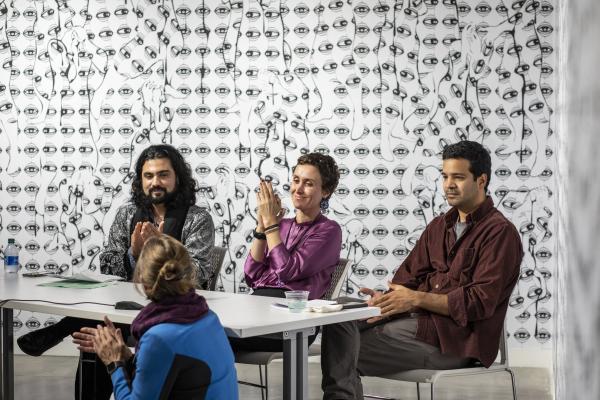
Illya Mousavijad curated Iran: Deciphering Violence and Resistance, an exhibit featuring ten contemporary Iranian artists living in Iran and the United States, with works that span across a diverse array of mediums. Each piece calls attention to the systemic violence perpetrated by Iran’s dictatorial monarchy against its citizens.
The exhibition is on view at Urban Arts Space from September 26–November 18, 2023, featuring the works of ten artists and activists: Roya Amigh, Maryam Ashrafi, Parastou Forouhar, Barbad Golshiri, Illya Mousavijad, Mehran Najafi, Maaman Rezaee, Fatemeh Shams, Omid Shekari, and Jinoos Taghizadeh.
In this interview, Illya answers questions regarding the exhibition and how art works as a form of activism in the face of institutional oppression and violence.
How did you come to know the artists contributing their work? How have their contributions shaped the nature of this exhibition?
I met some of the artists in person throughout the years and have spoken or collaborated with them before. Omid Shekari for example is an old friend from my undergraduate years at Pennsylvania Academy of the Fine Arts. He was a grad student there. I met Fatemeh Shams in Philadelphia, in one of my favorite cafés in front of the Rittenhouse Square. Later on, we crossed paths often at UPenn, where I ended up going for grad school.
I got to know many of the artists through their work, on social media, and word of mouth or personal introductions. The contributions and participation of these artists have fundamentally shaped this exhibition. I feel tremendously lucky that I could work with such great artists, but also wonderful people. Their patience, trust, and of course, their profound artworks have shaped the nuanced political, conceptual, and philosophic aspects of the exhibition. Thanks to the featured artists, this show is very deep and nuanced in its attempt to express the Iranian collective trauma and the Woman, Life, Freedom movement with care and criticality, and crucially away from superficial, capitalistic, and reductive representations.
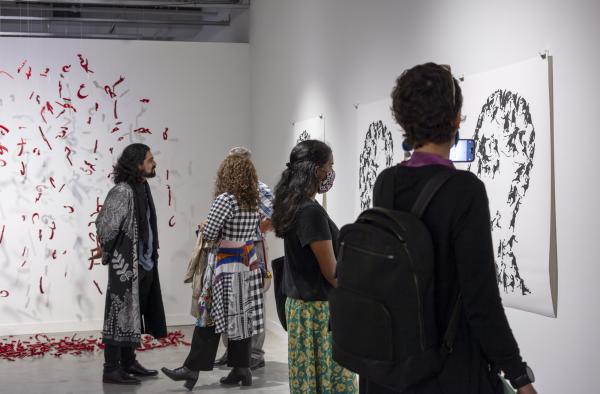
A wide variety of mediums are used in this exhibition, from photography to animation. In what ways do you feel this diverse background of crafts work with and add to the exhibition?
The diversity of medium or interdisciplinarity in this exhibition challenges and surpasses language’s attempt in articulation of the concepts, pain, and experience. The various creative approaches of making presented various entry points for the viewer to feel, to see, to hear, and to think.
Many works in this exhibit touch on the prevalent issue of violence in Iran. How do you and the collaborating artists balance these depictions of government-sanctioned violence while avoiding Western stereotypes regarding violence in Iran?
This is a great question. I struggled greatly with this. Even to put “violence” next to “Iran” in the title and for a show of this scale in the Midwest, here in the US. Firstly, I think every artwork in this exhibition is very sophisticated and multilayered. It is not possible to pick and leave with only one element, message, or thought from this exhibition, unless one passes through superficially! And there is nothing I can do about that!
Second, I think there is a point in which negotiating with the devil becomes impossible. Violence is violence at any scale. But there are thresholds after which it becomes paralyzing and unthinkable. Such naked injustice and violence that the Iranian people have been breaking under must be denounced with rigor and attention. It would have been absolutely impossible to make this exhibition project in Iran. So, I had to make it in exile. It is nuanced. And it is imperfect. However, I just had to do something, within the best of my ability and within my resources. And I think it was certainly the right thing to do.
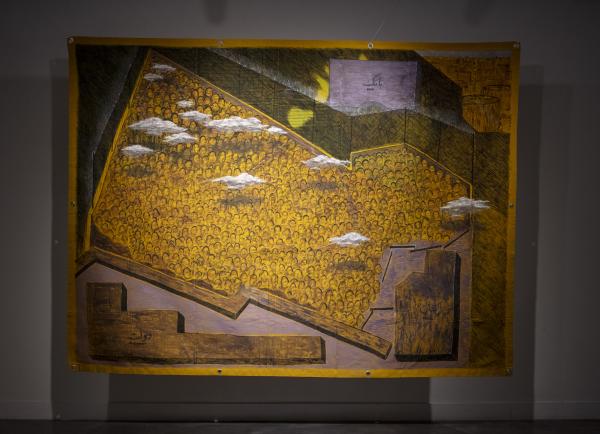
The piece you and Fatemah Sham’s created, This is Not a Poem, is formed with sculpted calligraphy that creates a deconstructed poem. How do you feel language barriers impact protest and solidarity between regions of the world?
I have a love and hate relationship with language. I think language that is at the center of human thought and communication is fundamentally overrated. There are other ways of expression, thinking, and feeling. Poetry is in a way a step in while simultaneously also a step away from language. It tries to achieve what language often struggles with. This is Not a Poem is a fantastic poem by Fatemeh Shams. It is monument for the currents and movements of Iran, but as the title verifies, it is also a poem about the limits of language. Not the barrier between one and another language, but any language’s very limits in capturing the weight and essence of collective trauma. I tried to manifest this formally in the sculptural form within this installation. Subverting the fluidity of ink on paper to solid shapes that are heavy, but also scattered, displaced, and fragile. I was interested in the effect of language instead of its literal articulation.
Who has been your biggest inspiration in life and as an artist?
This one is very hard to answer, at least in the context of this exhibition. There are many. I am very inspired by one of my professors at UPenn, Joshua Mosley. He is an amazing animator and artist, although his art practice is not at all related to this exhibition. Sharron Hayes, also at UPenn, is another wonderful artist and activist. And there are many other amazing figures. Walid Raad? Ian Cheng? Parastou Forouhar? Trust me the list can go on. I love all the artists in this exhibition too and feel very inspired by their work.
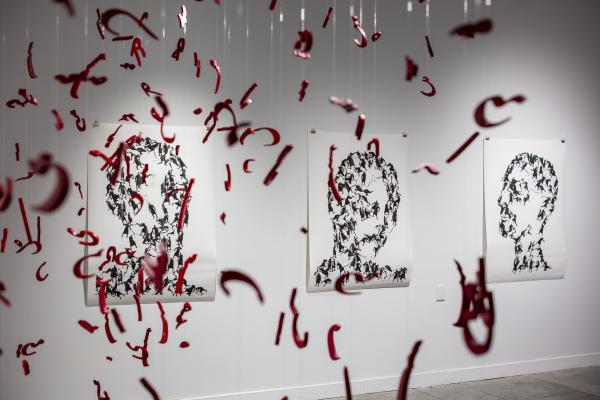
Maaman Rezaee’s Family of Too Many is a particularly powerful short film about the difficulties faced by those of the Baháʼí Faith living in Shi’a Iran. How do you feel the film speaks to audiences who may be unaware of these religious customs?
I think Maaman’s film Family of Too Many actually does a great job of opening and unfolding the very complex aspects of the violence that the Baháʼí community faces in Iran. The societal pressure, the family’s stubborn dogmas aligning with the suppressive laws made against this community by the Islamic Republic, and how they relate or differ. It is a very powerful film.
The exhibit features a collection of posters from over 48 artists, each piece commentating on the protests for justice in Iran. How did this collaboration come together, and how has the support from all of these artists impacted you?
This wall containing all these wonderful posters designed by over 48 artists and graphic designers was curated by Maryam Ashrafi. All credits for this collection goes to her, and she is listed as the co-curator in the exhibition. Maryam made all the necessary connections and gathered this valuable collection. This collection has been growing and traveling. It has been exhibited in Europe so far. Hopefully it continues to grow and travel.
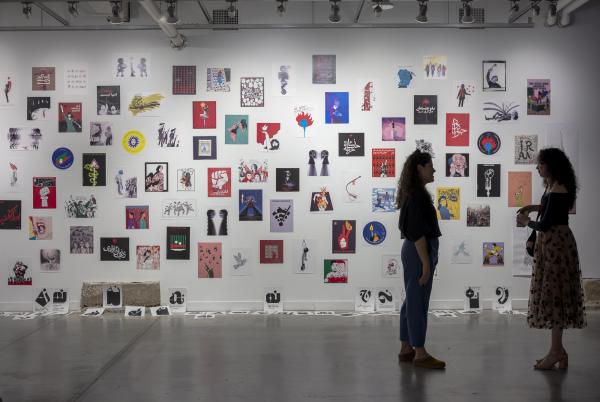
What message do you hope viewers will take away from this exhibition? What can they do to contribute to making Iranian voices heard?
It is not possible, and in fact counterproductive to say that there is one message out there. But I think this exhibition tries its best to at least make a memorial for the suffering of the Iranian people. This show expresses, denounces, and protests the systematic violence of the Islamic Republic. This regime operates with manifold injustice: Islamic-fascism, economic distress, sexism, environmental disasters, mismanagement, marginalized communities, corruption, and more. I think making awareness is a goal. People can promote the exhibition by inviting their friends and people in their circle to visit, to think, and to spread the word, to give room to the silenced voices of the undermined identities.
